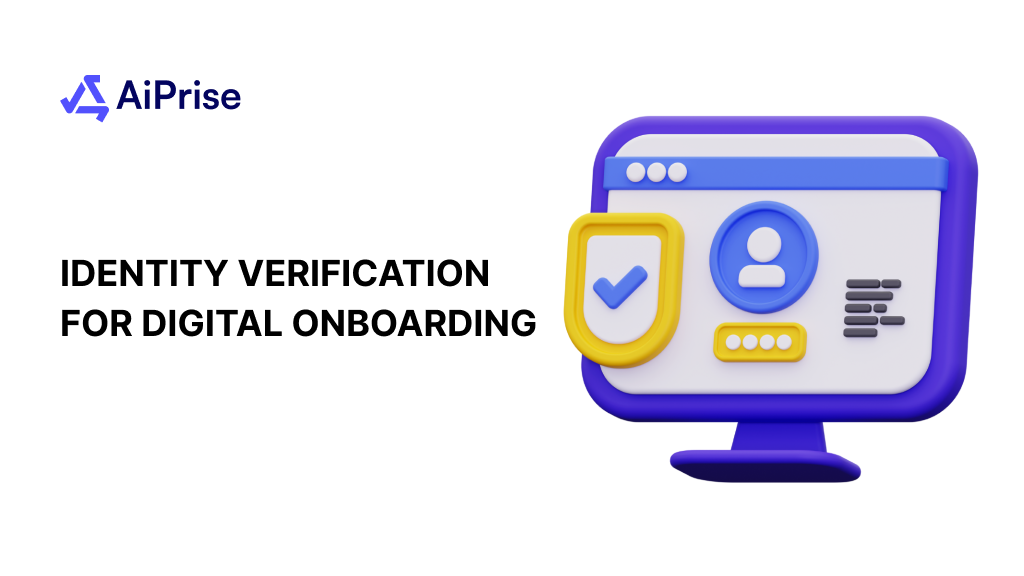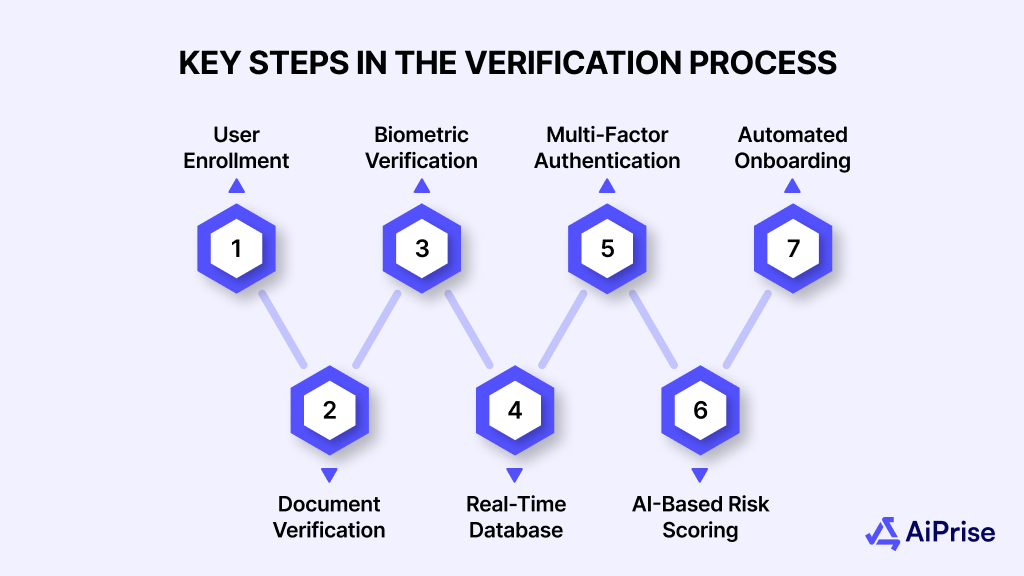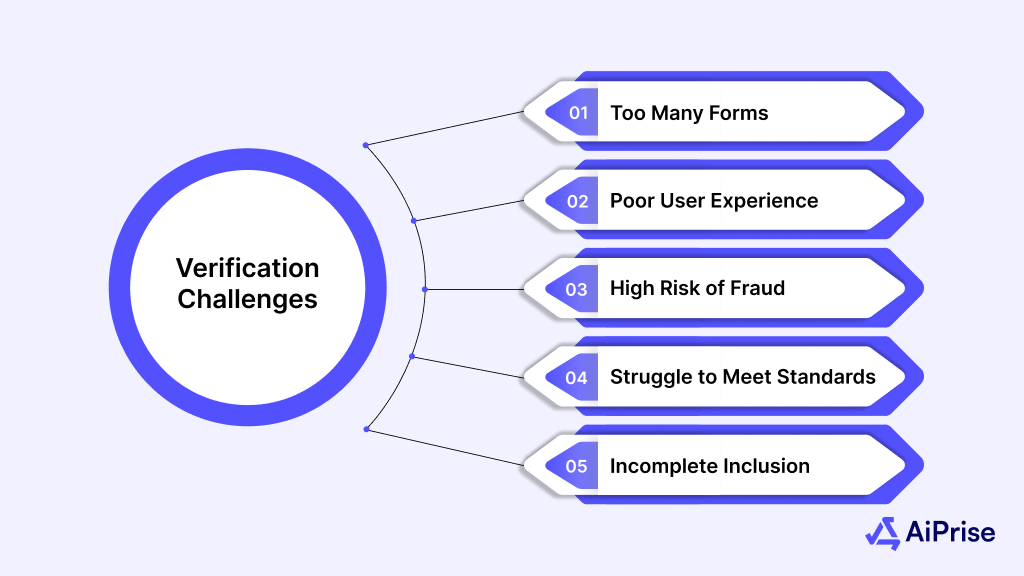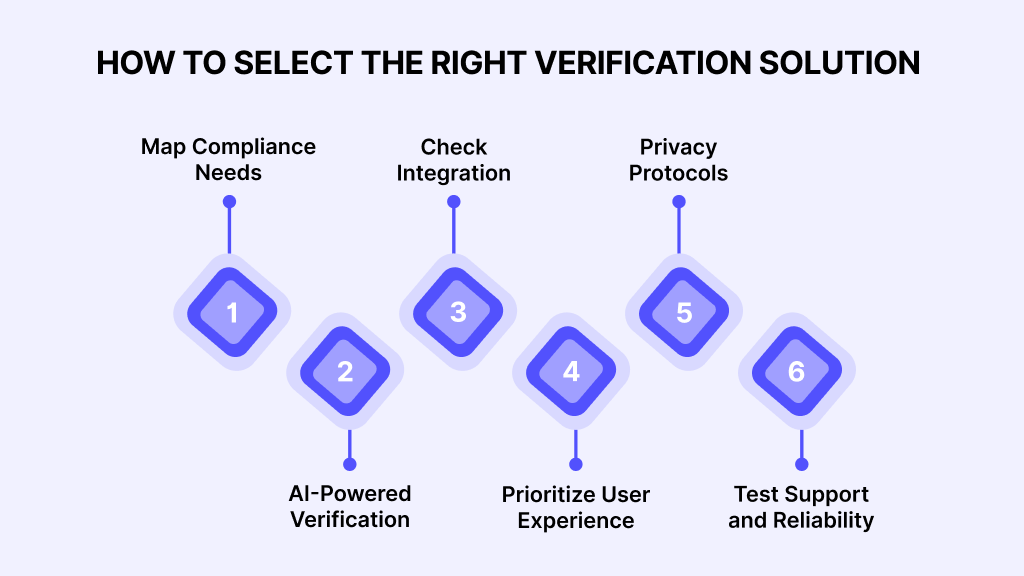AiPrise
13 mins read
July 22, 2025
Identity Verification for Digital Onboarding: The Complete Guide

Key Takeaways










Digital onboarding can open new doors for your business, but only if you get identity verification right. With synthetic identities making up 85% of financial fraud cases in 2024, strong verification is no longer optional; it's a business imperative.
Not only does inefficient onboarding cause frustration, but it also leads to lost opportunities: 38% of potential customers abandon the process due to slow or manual verification systems.
This blog explains how smart identity verification for digital onboarding works. You'll find practical strategies and the latest methods that can help you simplify onboarding, stay compliant, and protect your business against fraud threats.
Key Takeaways
- Reduce fraud and simplify compliance using automated identity verification during digital onboarding.
- Layer document, biometric, and database checks to block fake accounts while onboarding users instantly.
- Stay KYC/AML compliant automatically to dodge fines and legal issues.
- Skip strong verification, and you risk fraud losses, lost trust, and higher churn rates.
What Is Identity Verification For Digital Onboarding?
Digital onboarding is the process of bringing new customers, clients, or users into a digital service or platform. Identity verification for digital onboarding is the critical step within this process where a business remotely confirms that a new user is genuinely who they claim to be. This ensures the legitimacy of their identity from the very first interaction, without the need for face-to-face contact.
Modern digital identity verification combines advanced technology and regulatory expertise to deliver seamless, secure onboarding. It analyzes not only government-issued IDs but also live biometrics, behavioral data, and authoritative databases, all in real-time. This multi-layered approach ensures comprehensive authentication of new users.
By accurately verifying identities upfront, businesses can successfully expand their digital ecosystem with trust and security, while providing a seamless user experience.
Next, let's understand why identity verification is critical and what impact it has on your onboarding outcomes and business security.
Why Identity Verification for Digital Onboarding is Important?
Digital onboarding is more than just a customer entry point; it sets the foundation for trust, compliance, and efficiency in your business. Using strong identity verification during onboarding is vital for several reasons:
- Fraud Prevention and Risk Mitigation: Identity fraud continues to rise globally, costing businesses billions annually. Reliable verification blocks fake or stolen identities before they cause damage, protecting your revenue and reputation.
- Regulatory Compliance: Laws like KYC (Know Your Customer) and AML (Anti-Money Laundering) require strong identity checks. Automated verification helps you meet these evolving standards quickly while avoiding costly penalties.
- Cost and Time Efficiency: Manual identity checks are labor-intensive, error-prone, and slow. Automated systems cut onboarding time from days to minutes, reduce staffing costs, and improve accuracy by eliminating human error.
- Scalability and Accessibility: Digital identity verification works 24/7, enabling your business to onboard users anywhere, anytime, and at scale, vital as remote services and global markets expand.
Now that you know the importance, let's walk through each essential step in a modern digital identity verification process.
Key Steps in the Digital Identity Verification Process

To truly protect your digital onboarding, it’s crucial to follow a standardized, multi-layered verification process. Here’s how best-in-class platforms combine technology and data to verify identities:
- User Enrollment and Data Collection
You capture key personal details and official identification (like a passport or driver’s license) through encrypted web forms or mobile uploads.
Many platforms also collect digital fingerprints, such as device data or location, to spot potential fraud. - Document Verification and Authentication
Advanced OCR and security feature detection analyze ID documents for authenticity, ensuring documents haven’t been forged, tampered with, or expired.
Document details, MRZ, and templates are validated, cross-checking the issuing authority and version for extra reliability. - Biometric Verification and Liveness Detection
Users take a real-time selfie or fingerprint scan; AI compares this sample to the ID photo and ensures the person is physically present, not spoofing with a photo or mask.
Liveness detection and anti-spoofing checks are essential to defeat deepfakes and synthetic ID attempts. - Real-Time Database and Supplementary Checks
Your system automatically cross-references user data with government, financial, and credit bureau databases, quickly alerting you to mismatches, sanctioned parties, or identity theft.
Device, IP, and behavioral analysis detect suspicious activity patterns like unusual geolocation or proxy use, enhancing fraud prevention by identifying anomalies in user behavior. - Knowledge-Based and Multi-Factor Authentication
For high-stakes use cases, you can layer in out-of-wallet security questions or require users to complete two-factor authentication with a one-time code sent to their registered device. - AI-Based Risk Scoring and Decision Making
AI and machine learning analyze verification data to calculate a risk score, automatically approving low-risk cases while escalating suspicious ones for human review, thus optimizing decision efficiency. - Instant, Automated Onboarding
When everything checks out, users receive nearly instant approval. Fully automated workflows eliminate manual bottlenecks, boosting conversion rates and keeping customers happy.
Now let's focus on how you can make your digital identity verification not just effective, but also user-friendly and future-proof.
Identity Verification for Digital Onboarding: Best Practices
Adopting proven best practices means your identity verification process does more than just fulfill requirements; it actively blocks fraud, reduces onboarding friction, and ensures full regulatory compliance. By emphasizing security, convenience, and scalability throughout, you protect your business and provide an onboarding experience that your customers trust and complete.
Here’s how to optimize each stage:
- Streamline for Mobile Users: Deliver onboarding designed for smartphones, with single-tap uploads and automatic photo cropping so users can complete verification in under two minutes.
- Deliver Clear, Instant Feedback: Guide users step-by-step and alert them in real time if document images are blurry, expired, or missing, reducing abandonment rates and support queries.
- Layer Security Methods: Require an ID scan, live selfie, or fingerprint, plus instant checks against government and credit databases, blocking synthetic and deepfake fraud attempts before they reach your systems.
- Automate Risk Checks: Use AI to instantly extract data from IDs and spot red flags and score risk, so you approve genuine users in seconds and only review cases that truly need manual attention.
- Enforce Ongoing Compliance: Integrate automated KYC/AML updates and regularly audit your workflow, so you respond rapidly to new regulations without disrupting onboarding.
- Lock Down Privacy: Encrypt all personal data in transit and at rest, and display a privacy agreement that requires a single-click user consent before processing begins.
- Constantly Improve Results: Track real-time drop-off rates, run A/B tests on workflow tweaks (like new selfie guidance screens), and update instructions based on user feedback to push completion rates higher.
- Opt for Plug-and-Play Integration: Adopt platforms with API connections that fit your tech stack, so you can add, upgrade, or scale identity verification in days, not months, without a heavy IT lift.
To ensure your onboarding process is both secure and user-friendly, it’s crucial to tackle the common challenges that hinder digital identity verification.
Challenges in Identity Verification for Digital Onboarding

Identity verification for digital onboarding comes with hurdles like fraud risks, time-consuming manual processes, and compliance complexities. If verification is slow or clunky, you’ll face high abandonment rates because users leave when onboarding gets too complicated.
Here are common identity verification challenges along with their actionable solutions:
Too Many Forms Causing Drop-offs
- When you require customers to fill out multiple, repetitive forms, frustration skyrockets, and up to 68% of users abandon the process, resulting in lost conversions and revenue.
- Solution: Automate data entry using OCR and pre-filled field technology. Integrate document scanning tools within your app, so users only snap a photo, and the fields are filled instantly.
Poor User Experience and Accessibility Barriers
- Legacy systems can't keep up with today’s customer expectations for mobile-first, fast experiences. Older verification methods also miss marginalized groups and people with low digital literacy, excluding them from services.
- Solution: Design mobile-optimized workflows, support multiple languages, and offer alternative verification (like live video chat or social logins) to reach everyone. Run A/B tests and gather user feedback to continually enhance usability.
High Risk of Fraud and Sophisticated Attacks
- As verification gets more digital, fraudsters use deepfakes, synthetic IDs, and social engineering to bypass weak checks. Manual reviews are too slow and error-prone.
- Solution: Implement advanced defenses, including AI-based document checks, biometric verification with liveness detection, and real-time background checks against global watchlists. Utilize behavioral analytics to identify unusual or high-risk user patterns.
Struggle to Meet Evolving Compliance and Data Privacy Standards
- Global regulations like KYC, AML, and GDPR keep changing. Failing to comply exposes you to reputational damage and steep fines.
- Solution: Choose automated solutions that update compliance protocols in real time and encrypt all customer data. Make your privacy policy transparent and require explicit user consent for data use.
Incomplete Inclusion and Verification Gaps
- Many solutions are inflexible and can’t verify customers who have no fixed address or limited ID documents, causing financial exclusion.
- Solution: Offer fallback options, such as video verification, or accept a wider range of credible identity sources. Continuously evaluate and adapt your systems to promote inclusivity, thereby closing these verification gaps.
It's clear that skipping robust identity verification for digital onboarding is not just a technical gap; it's a direct threat to revenue and compliance. Let's have a look at the risk of not implementing digital verification.
The Risk of Not Implementing Identity Verification for Digital Onboarding
Failing to implement identity verification in digital onboarding leaves organizations dangerously exposed to evolving fraud tactics and regulatory penalties. Over 97% of businesses report challenges with identity security, while 52% express serious concerns about compromised credentials, and only 45% use multi-factor authentication to protect against fraud.
The following are some of the risks of not implementing identity verifications:
- Massive Financial Losses: Identity fraud caused global losses of $43 billion in 2022 alone. Without digital verification, your business is wide open to account takeovers, fraudulent sign-ups, and unauthorized transactions that directly erode profits.
- Soaring Customer Abandonment: Nearly half of consumers abandoned online sign-ups in the past year because they found the process untrustworthy or too difficult. Without trustworthy verification, you lose legitimate users to rivals with safer onboarding.
- Brand Trust and Lasting Reputation Damage: 77% of Americans say they're less likely to engage with a business after learning it allowed fraud during onboarding. Letting fraud slip through does more than cause direct losses; it also deters future customers and erodes cross-selling opportunities.
- Regulatory and Compliance Penalties: Without proper identity verification, meeting KYC and AML compliance is nearly impossible. This exposes you to fines, sanctions, and regulatory investigations, especially in industries where digital onboarding is now the norm.
- Unmanageable Operational Costs: Traditional identity checks are slow, manual, and prone to error, leading to high drop-off rates, support tickets, and wasted staff hours. This inefficiency means lost revenue and scalability challenges as digital interactions increase.
Once you recognize the risks of weak onboarding, your next move is to choose a solution that actually delivers results, not just a vendor with a long feature list.
How To Select the Right Identity Verification Solution

Choosing the best identity verification solution is essential for secure, compliant, and user-friendly onboarding. Prioritize platforms that offer real-time, AI-based verification, global ID coverage, and seamless integration with your existing systems.
Focus on these pointers to select the right identity verification solution:
- Map Your Compliance and Industry Needs: Before anything, identify the regulations you must meet (like KYC, AML, GDPR). Financial journeys now start online, and regulatory investigations frequently target gaps in identity checks.
- Demand Real-Time, AI-Powered Verification: Manual review means high drop-off and fraud risk. Choose platforms using AI and machine learning to automate document checks, biometrics, and risk scoring. Leading solutions now complete user verification in seconds; delays cost conversions and security.
- Check Integration and Scalability Upfront: Your platform must connect frictionlessly with existing onboarding tools (via APIs or SDKs) and support your growth without speed or coverage issues. Top-tier products offer “plug-and-play” modules and real-time support for global scaling.
- Prioritize User Experience: Complex processes are conversion killers; almost half of users abandon outdated or inefficient onboarding. Select solutions with mobile-first UX, instant photo feedback, language localization, and progress indicators.
- Vet Security and Privacy Protocols: Look for platforms that encrypt all PII at rest and during transmission and have documented data protection and breach response plans. With rising credential compromise, only a few companies use multi-factor authentication; they favor vendors with built-in 2FA/biometric layers.
- Test Support and Reliability: Round-the-clock technical support and high uptime are baseline requirements. Check vendor case studies or references for proven results in your industry before committing.
Having explored how to select the right identity verification solution, let’s look specifically at how AiPrise empowers businesses to tackle onboarding, fraud, and compliance with advanced, data-driven tools.
How AiPrise Helps Businesses in Identity Verification?
AiPrise delivers a high-performance, global identity verification platform built for scale, compliance, and advanced fraud protection.
Here’s how it stands out in enabling secure and efficient digital onboarding:
- Verifies IDs from 200+ countries in under 30 seconds with AI-driven OCR, barcode/MRZ scanning, and enhanced security feature checks for over 12,000 document types.
- Performs biometric checks (facial recognition, liveness detection) to prevent spoofing, deepfakes, and synthetic identity fraud.
- Integrates with 800+ data sources for instant cross-referencing against government, credit, and sanctions lists, ensuring global KYC and KYB compliance.
- Customizable rule engine and risk scoring: Tailor onboarding flows and risk thresholds, automating low-risk approvals and escalating high-risk cases for review, reducing manual review time by up to 95%.
- Continuous monitoring and real-time fraud alerts keep you ahead of evolving scams and regulatory changes, with automated adverse media and ownership checks.
- White-label UI, rapid SDK/API integration, and multi-language support enable quick go-live (often within a week) and an inclusive, branded onboarding experience.
AiPrise equips businesses with end-to-end, real-time identity and business verification, fully automated compliance, and advanced fraud defense, all in a single, scalable platform.
Conclusion
Strong digital identity verification is no longer optional; it's essential for secure onboarding, regulatory compliance, and preventing costly fraud. Utilizing a solution like AiPrise empowers your business to verify identities accurately and instantly, reduce operational overhead, and enhance user experience at scale.
Book a Demo today, and see how AiPrise can accelerate your signups, cut risk, and delight your users from day one.
FAQs
1. What happens if your ID is expired or damaged? Can you still be verified?
Most digital identity verification platforms require a valid, unexpired government-issued ID with all details clearly visible. Expired or physically damaged IDs are typically rejected, so users should always submit current, undamaged documents.
2. How quickly does digital identity verification usually take?
Advanced systems complete verifications in seconds to under a minute by using AI and database checks. However, if a case is flagged for manual review, it might take a few hours or up to one business day, depending on complexity and volume.
3. Can digital onboarding work if you don’t have a passport or driver’s license?
Some platforms accept alternate documents, such as national ID cards, residence permits, or verified bank documents, but the accepted types depend on your location and the company's local compliance rules.
4. Is it safe to upload your personal documents and selfies during onboarding?
Reputable onboarding providers use strong encryption for both storage and transfer of your data. They comply with regulations (like GDPR/KYC) to protect your privacy and ensure documents are only accessible to authorized personnel.
5. What if your internet gets interrupted during verification?
Most modern onboarding solutions offer session saving and allow you to resume from the last completed step. If the upload is incomplete due to connectivity issues, you'll generally need to restart your verification once you’re reconnected.
You might want to read these...

Aiprise has helped streamline our KYB (Know Your Business) flow in 100+ countries. No other tool comes close.





Speed Up Your Compliance by 10x
Automate your compliance processes with AiPrise and focus on growing your business.





